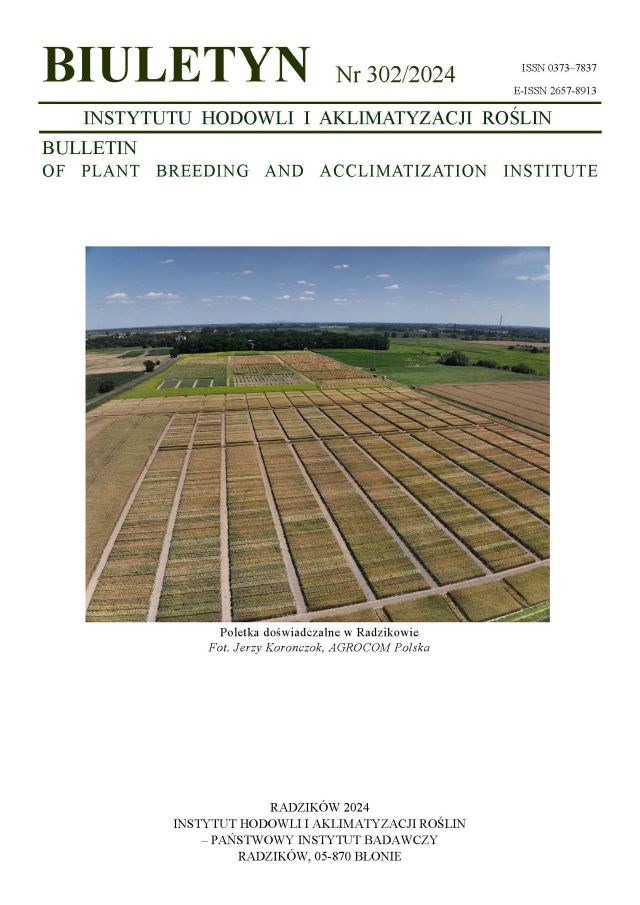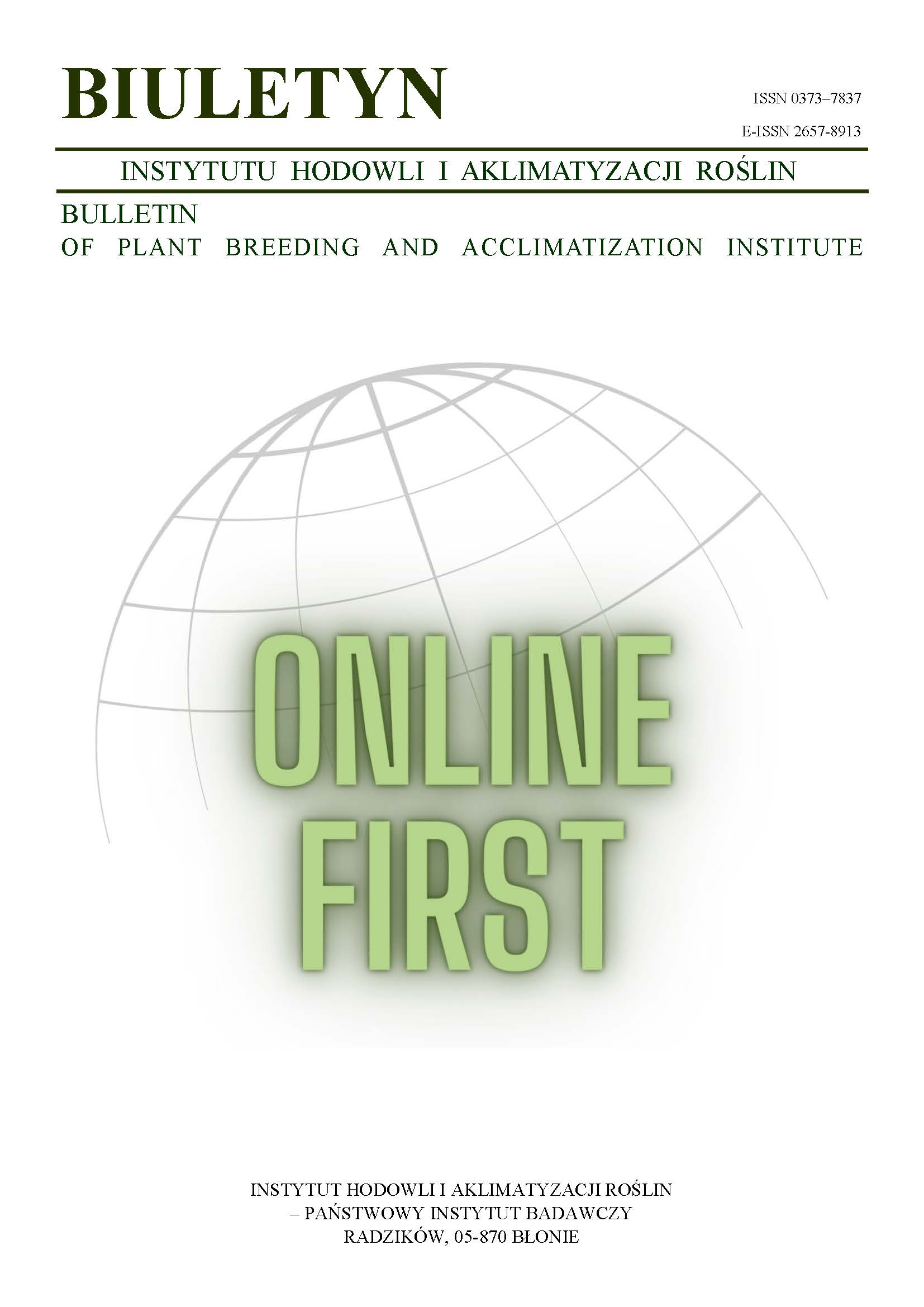An attempt at elaboration of a synthetic method for evaluation
Jacek Chotkowski
j.chotkowski@ihar.edu.plInstytut Hodowli i Aklimatyzacji Roślin, Zakład Nasiennictwa i Ochrony Ziemniaka w Boninie (Poland)
Tomasz Pilecki
Instytut Hodowli i Aklimatyzacji Roślin, Zakład Nasiennictwa i Ochrony Ziemniaka w Boninie (Poland)
Abstract
An attempt to create the system of estimation of potato varieties is presented. It can be used in the process of selection of varieties for cultivation. The suggested synthetic index of valorization of table potato varieties includes 20 factors divided into 3 groups: morphology, cooking quality of tubers, technological factors that make the production easier. The most important for a purchaser (consumer) will be the quality, due to the growing competitiveness on the market. The created ranking indicates that table potato varieties cultivated in Poland are comparative to foreign varieties, as far as the estimated factors are concerned.
Keywords:
selection for cultivation, quality, variety, potatoReferences
Charakterystyka zarejestrowanych odmian ziemniaka. 2004. Pr zbior. pod red. A. Głuskiej i K. Zgórskiej. Wyd. VIII, IHAR Jadwisin: 1 — 32.
Google Scholar
Chotkowski J. 2003. Rynkowe uwarunkowania nasiennictwa ziemniaka. Post. Nauk Rol., 1: 67 — 79.
Google Scholar
Chotkowski J., Wróbel S. 2001. Dobór odmian w nasiennictwie i produkcji ziemniaka w wybranych regionach Polski. Biuletyn IHAR, 220: 207 — 214.
Google Scholar
Chotkowski J., Turska E., Borys J. 2002. Kryteria doboru i charakterystyka skrobiowych odmian ziemniaka W: Ekonomika i technologia produkcji ziemniaków skrobiowych. Pr. zbior. pod red. J. Chotkowskiego. Wieś Jutra, Warszawa: 74 — 84.
Google Scholar
Gacek E. 2003. Zasady wpisu odmian roślin uprawnych do krajowego rejestru i wspólnotowych katalogów w aspekcie akcesji Polski do UE. Hod. Rośl. i Nasien. 3: 6 — 9.
Google Scholar
Heijman W., Krzyżanowska Z., Gędek Z., Kowalski Z. 1997. Ekonomika rolnictwa. Zarys teorii. Fundacja “Rozwój SGGW”, Warszawa.
Google Scholar
Kamasa J. 2004. Ziemniak W: Lista opisowa odmian. Rośliny rolnicze, Cz. II Okopowe, Strączkowe. COBORU Słupia Wielka: 21 — 42.
Google Scholar
Kotler P. 1994. Marketing. Analiza, planowanie, wdrazanie i kontrola. Gebethner i S-ka, Warszawa.
Google Scholar
Nowacki W. 2004. Koncepcja systemu rekomendacji odmian ziemniaka jadalnego w oparciu o ich wartość użytkową i agrotechniczną W: Jakość towarowych surowców roślinnych wyzwaniem dla nauki i praktyki rolniczej. VIII Konf. Nauk IUNG, 31.05-01.06.2004, IUNG, Puławy: 67 — 68.
Google Scholar
Nowacki W., Głuska A., Gruczek T., Lis B., Lutomirska B., Roztropowicz S., Zarzyńska K. 2000. Uprawa ziemniaka a wartość konsumpcyjna i technologiczna bulw (W:) Ziemniak spożywczy i przemysłowy i jego przetwarzanie. Konf. Nauk. Polanica Zdrój, 08-11.05.2000, AR Wrocław, 23 — 32.
Google Scholar
Podlaski S. 1999. Możliwości konkurowania krajowych i zagranicznych odmian na naszym rynku. Hod. Rośl. i Nasien. 3: 4 — 10.
Google Scholar
Podolska G. 2005. Pszenica ozima (W:) Rynki i technologie produkcji roślin uprawnych. Pr. zbior. pod red. J. Chotkowskiego. Wieś Jutra, Warszawa: 99 — 115.
Google Scholar
Świeżyński K. M., Domański L. 1997. Porównanie odmian ziemniaka Polski, Niemiec i Holandii pod względem wczesności i jakości bulw. Biul. Inst. Ziemn., 48/II: 37 — 52.
Google Scholar
Authors
Jacek Chotkowskij.chotkowski@ihar.edu.pl
Instytut Hodowli i Aklimatyzacji Roślin, Zakład Nasiennictwa i Ochrony Ziemniaka w Boninie Poland
Authors
Tomasz PileckiInstytut Hodowli i Aklimatyzacji Roślin, Zakład Nasiennictwa i Ochrony Ziemniaka w Boninie Poland
Statistics
Abstract views: 6PDF downloads: 5
License
Copyright (c) 2005 Jacek Chotkowski, Tomasz Pilecki

This work is licensed under a Creative Commons Attribution-ShareAlike 4.0 International License.
Upon submitting the article, the Authors grant the Publisher a non-exclusive and free license to use the article for an indefinite period of time throughout the world in the following fields of use:
- Production and reproduction of copies of the article using a specific technique, including printing and digital technology.
- Placing on the market, lending or renting the original or copies of the article.
- Public performance, exhibition, display, reproduction, broadcasting and re-broadcasting, as well as making the article publicly available in such a way that everyone can access it at a place and time of their choice.
- Including the article in a collective work.
- Uploading an article in electronic form to electronic platforms or otherwise introducing an article in electronic form to the Internet or other network.
- Dissemination of the article in electronic form on the Internet or other network, in collective work as well as independently.
- Making the article available in an electronic version in such a way that everyone can access it at a place and time of their choice, in particular via the Internet.
Authors by sending a request for publication:
- They consent to the publication of the article in the journal,
- They agree to give the publication a DOI (Digital Object Identifier),
- They undertake to comply with the publishing house's code of ethics in accordance with the guidelines of the Committee on Publication Ethics (COPE), (http://ihar.edu.pl/biblioteka_i_wydawnictwa.php),
- They consent to the articles being made available in electronic form under the CC BY-SA 4.0 license, in open access,
- They agree to send article metadata to commercial and non-commercial journal indexing databases.
Most read articles by the same author(s)
- Jacek Chotkowski, Irena Stypa, Estimation of breeding progress in potato production in Poland in the years 1946–2007 , Bulletin of Plant Breeding and Acclimatization Institute: No. 245 (2007): Regular issue
- Agnieszka Barnyk, Jerzy Lewosz, Krzysztof Treder, Włodzimierz Przewodowski, Tomasz Pilecki, Application of thiophilic chromatography for purification of polyclonal antibodies from rabbit serum , Bulletin of Plant Breeding and Acclimatization Institute: No. 248 (2008): Regular issue
- Włodzimierz Przewodowski, Jerzy Lewosz, Krzysztof Treder, Agnieszka Barnyk, Tomasz Pilecki, Identification of potato cultivars with an electrophoretic method , Bulletin of Plant Breeding and Acclimatization Institute: No. 243 (2007): Regular issue
- Jacek Chotkowski, Potential for reducing seed potato production costs , Bulletin of Plant Breeding and Acclimatization Institute: No. 257/258 (2010): Regular issue
- Jacek Chotkowski, The perspectives of potato production in Poland in seed companies’ opinion , Bulletin of Plant Breeding and Acclimatization Institute: No. 242 (2006): Special issue














